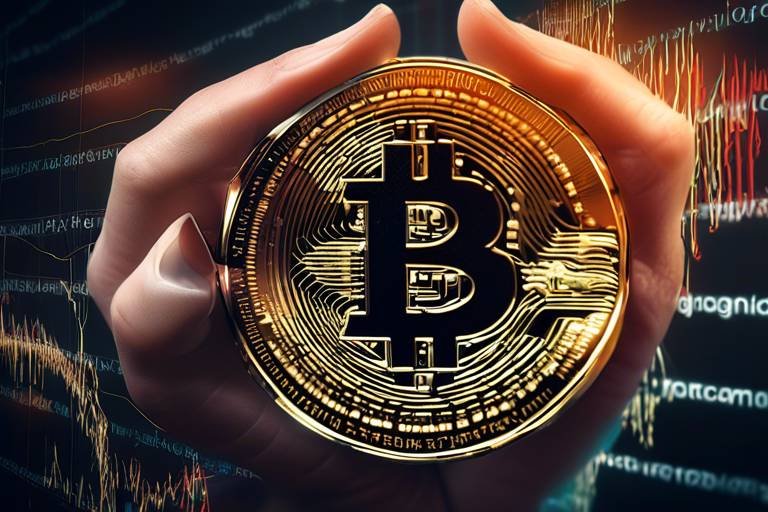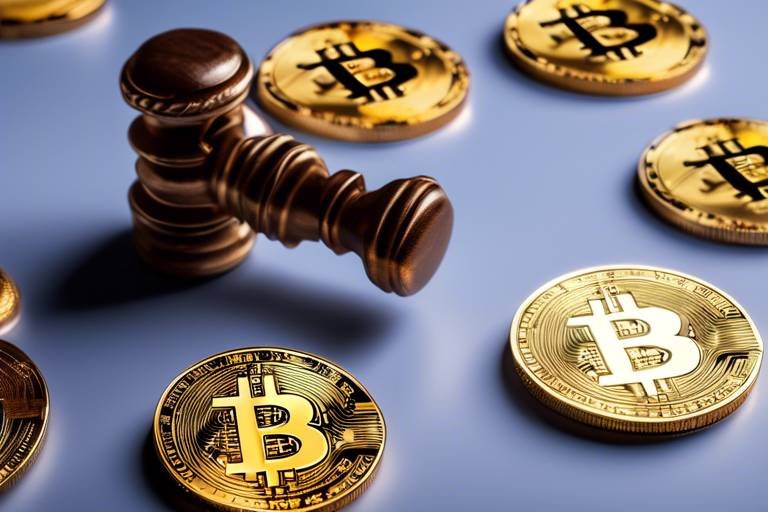The Future of DeFi - Trends to Watch in 2024
Decentralized Finance, or DeFi, is an exhilarating frontier in the world of finance that is rapidly evolving and reshaping how we think about money. As we step into 2024, the landscape of DeFi is poised for significant changes, driven by innovations that promise to enhance user experience, improve transaction efficiency, and create new opportunities for investors. With the rise of decentralized exchanges, layer 2 solutions, interoperability, and a shifting regulatory environment, it’s crucial to stay informed about the trends that will define this space in the coming year. So, what can we expect? Let's dive into the details!
Decentralized exchanges are the beating heart of the DeFi ecosystem, providing a platform for users to trade cryptocurrencies without the need for a central authority. As the popularity of DEXs continues to soar, we will witness their evolving role in the financial landscape. One of the most exciting aspects of DEXs is their ability to offer liquidity provision through automated market makers (AMMs). This mechanism not only ensures that users can trade assets seamlessly but also allows liquidity providers to earn rewards, creating a win-win situation.
Moreover, user experience is set to improve dramatically in 2024. With advancements in interface design and the integration of more user-friendly features, even those who are new to crypto trading will find it easier to navigate DEXs. Integration with traditional finance is another area to watch, as partnerships between DeFi platforms and established financial institutions could pave the way for broader adoption. Imagine being able to trade your stocks and cryptocurrencies all in one place! This convergence could redefine how we interact with our assets.
Layer 2 scaling solutions are like the turbo boosters of blockchain technology, designed to enhance transaction speeds and reduce costs. As Ethereum continues to be the backbone of many DeFi applications, the implementation of Layer 2 technologies will be crucial in addressing the network's congestion issues. These solutions promise to make transactions faster and cheaper, which is vital for the growing number of users flocking to DeFi platforms. In 2024, we can expect to see a surge in the adoption of various Layer 2 solutions, each bringing unique features and benefits to the table.
Among the most promising Layer 2 solutions are optimistic rollups. These technologies work by processing transactions off-chain and then bundling them together before submitting them to the main Ethereum chain. This method significantly improves scalability while maintaining security. Optimistic rollups can handle thousands of transactions per second, making them a game-changer for DeFi applications that require high throughput.
The advantages of optimistic rollups are hard to ignore. They not only increase transaction throughput but also lower fees, making DeFi more accessible to a broader audience. Users can enjoy faster transactions without the hefty gas fees that have become synonymous with Ethereum. This accessibility can lead to increased participation in DeFi, driving innovation and growth across the ecosystem.
However, it's essential to recognize that optimistic rollups are not without their challenges. Security concerns and potential latency issues could hinder their widespread adoption. For instance, if a transaction is processed off-chain, there's a risk that it could be manipulated before being confirmed on-chain. As we move forward, addressing these limitations will be critical in ensuring the growth and reliability of DeFi applications.
Another layer 2 solution gaining traction is ZK-rollups. Unlike optimistic rollups, ZK-rollups utilize zero-knowledge proofs to validate transactions, enhancing both privacy and efficiency. This technology allows for the bundling of numerous transactions into a single proof, which is then submitted to the main chain. This not only reduces the data load on the Ethereum network but also ensures that user data remains private, a crucial aspect for many in the DeFi space.
As the DeFi ecosystem grows, interoperability will become increasingly vital. The ability for different blockchain networks to communicate and exchange assets seamlessly is what will drive the next wave of innovation. Cross-chain solutions are emerging to facilitate these interactions, enabling users to leverage the strengths of multiple blockchains.
Cross-chain protocols are the bridges connecting disparate blockchain ecosystems. They allow for asset transfers and communication between different networks, creating a more integrated DeFi landscape. In 2024, we can expect to see key players and technologies emerge that will enhance interoperability, making it easier for users to navigate the DeFi space.
Bridging solutions are essential for ensuring that users can move their assets freely across different blockchains. As these technologies continue to evolve, we will see significant developments that will simplify the process of connecting to various ecosystems. This will not only enhance user experience but also encourage more users to participate in DeFi.
The regulatory environment surrounding DeFi is in a state of flux, and by 2024, it is expected to evolve significantly. As governments around the world begin to formulate regulations for DeFi, understanding these changes will be crucial for developers and users alike. Regulations can either foster innovation or stifle it, depending on how they are implemented.
Different countries are approaching DeFi regulation in unique ways. Some are embracing it, while others are taking a more cautious stance. In 2024, we will explore these global trends and their implications for developers and users in the DeFi space. It’s essential to stay informed, as the regulatory landscape can have a profound impact on the future of DeFi.
Compliance remains a significant hurdle for DeFi projects. Developers face the daunting task of ensuring that their platforms adhere to regulations while maintaining the core principles of decentralization. This balancing act will be crucial as we move into 2024, and overcoming these challenges will be key to the sustainability and growth of DeFi.
- What is DeFi? DeFi, or decentralized finance, refers to financial services that operate on a blockchain without the need for a central authority.
- How do DEXs work? DEXs allow users to trade cryptocurrencies directly with one another using smart contracts, eliminating the need for intermediaries.
- What are Layer 2 solutions? Layer 2 solutions are technologies built on top of a blockchain that improve scalability and reduce transaction costs.
- What is interoperability in DeFi? Interoperability refers to the ability of different blockchain networks to communicate and exchange assets seamlessly.

Decentralized Exchanges (DEXs)
As we dive into the world of , it's essential to understand their transformative role in the evolving DeFi ecosystem. Imagine a marketplace where you can trade assets directly with others without the need for a middleman—this is precisely what DEXs offer. They empower users to maintain control over their funds, enhancing both security and privacy. In 2024, we expect to see DEXs not just grow in popularity but also evolve in functionality, providing a more seamless user experience.
One of the most exciting aspects of DEXs is their ability to facilitate liquidity provision. Liquidity is the lifeblood of any trading platform, and DEXs utilize innovative mechanisms like automated market makers (AMMs) to ensure that users can buy and sell assets without significant price slippage. This is particularly crucial for traders who are looking to execute large orders. As DEXs become more sophisticated, we can anticipate improved liquidity pools that cater to a wider variety of tokens, making the trading experience smoother and more efficient.
Another area where DEXs are set to shine is in their integration with traditional finance. As more traditional financial institutions dip their toes into the DeFi waters, we can expect partnerships that will bridge the gap between conventional finance and decentralized platforms. Imagine being able to trade your stocks and crypto assets on the same platform, with the same ease and speed—this is the future that DEXs aim to create. However, this integration will also bring challenges, particularly concerning regulatory compliance and user trust.
Moreover, the user experience on DEXs is continually being enhanced. With the advent of user-friendly interfaces and streamlined processes, even those who are new to crypto trading can navigate these platforms with ease. Features like limit orders and stop-loss orders are becoming more common, allowing traders to manage their risks effectively. As we move into 2024, expect to see a surge in educational resources aimed at helping users understand how to leverage these tools for their benefit.
However, DEXs are not without their challenges. Issues such as high gas fees on networks like Ethereum can deter users, especially during times of network congestion. Additionally, while DEXs promote decentralization and autonomy, they also face scrutiny regarding security vulnerabilities. Hacks and exploits can occur, leading to significant losses for users. Therefore, it’s crucial for traders to conduct thorough research and understand the risks associated with using DEXs.
In conclusion, DEXs are poised to play a pivotal role in the future of finance. They offer a glimpse into a decentralized world where users have full control over their assets, coupled with the potential for innovation that can reshape how we think about trading and liquidity. As we look ahead to 2024, staying informed about the latest developments in DEX technology and user experience will be vital for anyone interested in participating in the DeFi revolution.
- What is a DEX? A decentralized exchange (DEX) allows users to trade cryptocurrencies directly with one another without a central authority.
- How do DEXs ensure security? DEXs use smart contracts to facilitate trades, which reduces the risk of hacks associated with centralized exchanges.
- What are liquidity pools? Liquidity pools are collections of funds locked in a smart contract that provide liquidity for trading on DEXs.
- Can I trade any cryptocurrency on a DEX? While many DEXs support a wide range of tokens, availability can vary; always check the specific DEX for supported assets.

Layer 2 Solutions
In the ever-evolving world of decentralized finance (DeFi), are emerging as a game changer. Why? Because they tackle some of the most pressing issues that plague the primary blockchain networks, particularly Ethereum. As more users flock to DeFi platforms, the demand for faster transaction speeds and lower costs becomes critical. Layer 2 solutions, which operate on top of existing blockchains, aim to alleviate congestion and enhance user experience, making DeFi more accessible and efficient for everyone.
These solutions can be likened to a busy highway where traffic is often at a standstill. Layer 2 solutions act as express lanes, allowing vehicles (or transactions, in this case) to move swiftly without the usual delays. By processing transactions off the main chain and then settling them back on the blockchain, they significantly reduce the load on the primary network. This not only leads to faster transactions but also slashes gas fees, which can be a major barrier for users.
Among the most notable Layer 2 technologies are Optimistic Rollups and ZK-Rollups, each offering unique benefits and challenges. For instance, Optimistic Rollups assume transactions are valid by default, only checking for fraud when necessary, which boosts speed. On the other hand, ZK-Rollups utilize cryptographic proofs to validate transactions, enhancing privacy and efficiency. Understanding these differences is crucial for users and developers alike, as they navigate the DeFi landscape.
Let's dive deeper into the two leading technologies:
| Feature | Optimistic Rollups | ZK-Rollups |
|---|---|---|
| Transaction Validation | Assumes validity, checks only if challenged | Uses cryptographic proofs for validation |
| Speed | High speed due to minimal checks | Very high speed with efficient proofs |
| Privacy | Less privacy; data is visible on-chain | Enhanced privacy; data is not publicly visible |
| Complexity | Relatively simple implementation | More complex due to cryptographic methods |
As we look ahead to 2024, the impact of Layer 2 solutions on the DeFi ecosystem cannot be overstated. They promise not only to enhance user experience but also to foster greater adoption of decentralized applications (dApps). However, it’s essential to remain aware of the challenges these technologies face. Issues such as security vulnerabilities and potential latency could hinder their growth. Developers and users must stay informed and vigilant as they navigate this rapidly changing landscape.
In conclusion, Layer 2 solutions are paving the way for a more efficient and user-friendly DeFi experience. As we continue to explore these innovations, it’s clear that they will play a pivotal role in shaping the future of finance. So, buckle up and get ready for a thrilling ride through the world of decentralized finance!
- What are Layer 2 solutions? Layer 2 solutions are secondary frameworks built on top of existing blockchains to improve transaction speed and reduce costs.
- How do Optimistic Rollups work? They assume transactions are valid by default and only check for fraud if a challenge is raised.
- What are the benefits of ZK-Rollups? They provide enhanced privacy and efficiency by using cryptographic proofs for transaction validation.
- Are there any downsides to Layer 2 solutions? Yes, challenges such as security concerns and potential latency issues exist and need to be addressed.

Optimistic Rollups
As the world of decentralized finance (DeFi) continues to evolve, have emerged as a game-changing technology that promises to significantly enhance the scalability and efficiency of blockchain networks, particularly Ethereum. But what exactly are they? In simple terms, optimistic rollups are a type of Layer 2 scaling solution designed to process transactions off-chain while maintaining the security of the underlying blockchain. This means that they can handle a larger volume of transactions at a much faster pace, while keeping costs low. Imagine a busy highway where only a few cars can pass through at a time; optimistic rollups act like an express lane, allowing more vehicles to travel smoothly without congesting the main road.
One of the most exciting aspects of optimistic rollups is their potential to increase transaction throughput dramatically. How does this work? When a transaction is initiated, it is bundled with others and processed off-chain. The results are then submitted back to the main chain. This approach not only reduces the load on the Ethereum network but also lowers transaction fees, making DeFi applications more accessible to a broader audience. For instance, users can enjoy quicker transactions at a fraction of the cost they would typically incur. This is particularly beneficial for smaller investors who may have previously been deterred by high gas fees.
However, it's essential to understand that optimistic rollups are not without their challenges. While they offer remarkable benefits, they also come with certain limitations that developers and users should be aware of. For example, the reliance on fraud proofs means that there is a waiting period during which transactions can be challenged. This could lead to potential latency issues, which might frustrate users eager for immediate confirmations. Therefore, while optimistic rollups are a promising solution, they require careful consideration and ongoing development to address these challenges effectively.
In summary, optimistic rollups represent a significant leap forward in the DeFi landscape, offering enhanced scalability, lower fees, and a more user-friendly experience. As we look ahead to 2024, it will be fascinating to see how this technology evolves and integrates into various DeFi applications, ultimately shaping the future of finance. Are you ready to embrace the changes that optimistic rollups will bring?
- What are optimistic rollups? Optimistic rollups are Layer 2 solutions that allow for faster and cheaper transactions by processing them off-chain before submitting the results to the main blockchain.
- How do optimistic rollups improve transaction speeds? They bundle multiple transactions together and process them off-chain, reducing the load on the main chain and allowing for quicker confirmations.
- What are the main challenges of optimistic rollups? Key challenges include security concerns related to fraud proofs and potential latency issues due to the time taken to challenge transactions.
- Will optimistic rollups replace traditional transaction methods? While they offer significant advantages, they are likely to complement existing methods rather than completely replace them, providing users with more options.

Benefits of Optimistic Rollups
Optimistic rollups are revolutionizing the way we think about blockchain scalability, and their benefits are hard to ignore. Imagine a bustling city where traffic flows smoothly, thanks to well-planned roads and traffic lights. That’s what optimistic rollups aim to achieve for the Ethereum network, allowing it to handle significantly more transactions without the usual congestion. One of the most impressive advantages of optimistic rollups is their ability to increase transaction throughput. By processing transactions off-chain and only submitting the final results to the main Ethereum chain, they can handle thousands of transactions per second, compared to the mere dozen or so that the Ethereum mainnet can manage.
Moreover, lower transaction fees are a game changer. In a world where every penny counts, especially for smaller investors, optimistic rollups drastically reduce the cost of transactions. This accessibility opens the door for more users to participate in the DeFi ecosystem. Picture this: you want to swap tokens, but the gas fees are so high that it feels like you’re paying for a luxury car instead of a simple transaction. With optimistic rollups, those fees drop significantly, making DeFi more appealing to the masses.
Another critical benefit is enhanced user experience. With faster transaction times and lower costs, users can enjoy a seamless experience without the frustration of waiting for confirmations. It’s like ordering your favorite meal at a restaurant and having it served almost instantly rather than waiting for what feels like an eternity. This improvement in user experience can lead to higher adoption rates and increased engagement in DeFi platforms.
Furthermore, optimistic rollups maintain a high level of security. They leverage the existing security of the Ethereum blockchain, ensuring that even though transactions are processed off-chain, they are still protected by the robust security protocols of the mainnet. This combination of speed, cost-effectiveness, and security makes optimistic rollups an attractive option for developers looking to build scalable DeFi applications.
In summary, the benefits of optimistic rollups are profound and multifaceted. They enhance transaction throughput, reduce costs, improve user experience, and maintain strong security. As we move toward a more decentralized future, these advantages will play a crucial role in shaping the landscape of DeFi, making it more accessible and efficient for everyone involved.
As we continue to explore the potential of optimistic rollups, it’s essential to consider how these innovations will influence the broader DeFi ecosystem and what they mean for users and developers alike. The future looks bright, and optimistic rollups are surely paving the way for a more scalable and user-friendly decentralized finance experience.
- What are optimistic rollups? Optimistic rollups are a Layer 2 scaling solution that processes transactions off the main Ethereum chain to improve scalability and reduce costs.
- How do optimistic rollups enhance transaction speeds? By handling transactions off-chain and submitting only the final results to the main chain, optimistic rollups can significantly increase the number of transactions processed per second.
- Are optimistic rollups secure? Yes, optimistic rollups leverage the security of the Ethereum blockchain, ensuring that off-chain transactions are still protected by the mainnet's protocols.
- Will optimistic rollups lower transaction fees? Absolutely! One of the primary benefits of optimistic rollups is their ability to drastically reduce transaction costs, making DeFi more accessible.

Challenges and Limitations
While optimistic rollups present exciting possibilities for enhancing the scalability of decentralized finance (DeFi), they are not without their . One of the primary concerns is related to security. Since optimistic rollups rely on the assumption that transactions are valid unless proven otherwise, there is a risk that malicious actors could exploit this system. If a fraudulent transaction goes unnoticed, it could lead to significant losses for users. This security model places a heavy burden on the community to monitor and validate transactions, which can be a daunting task.
Another significant limitation is the potential for latency issues. Optimistic rollups can introduce delays in transaction finality, particularly during periods of high network congestion. Users may experience longer wait times before their transactions are confirmed, which can be frustrating, especially when compared to the instant transactions often expected in traditional finance. This delay could deter users from fully embracing DeFi platforms that utilize optimistic rollups.
Furthermore, the integration of optimistic rollups into existing DeFi applications can pose a challenge. Developers need to ensure that their platforms are compatible with these rollup solutions, which may require significant changes to the underlying code. This not only demands technical expertise but can also lead to increased development costs and time. As a result, smaller projects may struggle to adopt these technologies, potentially widening the gap between established players and newcomers in the DeFi space.
Lastly, there is the challenge of user education. Many users are still unfamiliar with the intricacies of optimistic rollups and how they function. This lack of understanding can lead to hesitancy in using DeFi platforms that employ these solutions. To overcome this, the community must invest in educating users about the benefits and risks associated with optimistic rollups, ensuring they feel confident in navigating this evolving landscape.
In summary, while optimistic rollups offer a promising avenue for enhancing DeFi scalability, they come with their own set of challenges. Addressing these limitations will be crucial for the widespread adoption of this technology and the continued growth of decentralized finance.
- What are optimistic rollups?
Optimistic rollups are a layer 2 scaling solution that enhances the throughput of blockchain networks by bundling multiple transactions together and submitting them to the main chain. They assume transactions are valid unless proven otherwise, which allows for faster processing.
- What are the main challenges of optimistic rollups?
The main challenges include security risks, potential latency issues, integration difficulties with existing platforms, and the need for user education.
- How do optimistic rollups differ from ZK-rollups?
While optimistic rollups rely on a validity assumption, ZK-rollups use cryptographic proofs to verify transactions, providing an additional layer of security and faster finality.
- Can optimistic rollups be used in all DeFi applications?
Not necessarily. Developers need to ensure compatibility with their existing platforms, which may require significant coding changes.

ZK-Rollups
ZK-rollups are rapidly emerging as a game-changing technology in the world of decentralized finance (DeFi). They represent a unique approach to scaling blockchain networks by bundling or "rolling up" multiple transactions into a single proof. This proof is then submitted to the main blockchain, allowing for a significant reduction in the amount of data processed on-chain. Imagine a busy highway where instead of each car (transaction) traveling individually, they all gather into a single bus (rollup) that takes them to their destination much faster and more efficiently. This not only enhances transaction speeds but also drastically reduces costs associated with on-chain operations.
One of the standout features of ZK-rollups is their ability to maintain privacy. Unlike other scaling solutions, ZK-rollups utilize zero-knowledge proofs, which allow one party to prove to another that a statement is true without revealing any additional information. This is crucial in DeFi, where users are increasingly concerned about their privacy and the security of their transactions. With ZK-rollups, users can transact with confidence, knowing that their sensitive information remains confidential.
Moreover, ZK-rollups help in achieving greater efficiency in the network. By compressing multiple transactions into a single proof, they significantly reduce the load on the main blockchain, allowing it to handle a larger volume of transactions without compromising speed or security. This efficiency is vital as DeFi platforms continue to grow and attract more users. As the demand for faster and cheaper transactions escalates, ZK-rollups are poised to play a pivotal role in meeting these needs.
However, it's essential to recognize that ZK-rollups are not without their challenges. The complexity of implementing zero-knowledge proofs can be a barrier for many developers. Additionally, while they offer enhanced privacy and efficiency, the technology is still in its early stages, and further advancements are required to ensure widespread adoption. The balance between security, scalability, and usability will be crucial as we move forward into 2024.
To summarize, ZK-rollups are set to revolutionize the DeFi landscape by providing a scalable, efficient, and private solution for transactions. As this technology matures, we can expect to see a surge in DeFi applications utilizing ZK-rollups, paving the way for a more robust and user-friendly financial ecosystem.
- What are ZK-rollups? ZK-rollups are a scaling solution that bundles multiple transactions into a single proof using zero-knowledge proofs, enhancing privacy and efficiency in blockchain networks.
- How do ZK-rollups improve transaction speeds? By aggregating multiple transactions into one proof, ZK-rollups reduce the amount of data processed on-chain, allowing for faster transaction confirmations.
- Are ZK-rollups secure? Yes, ZK-rollups utilize cryptographic proofs that ensure the integrity of transactions while maintaining user privacy.
- What challenges do ZK-rollups face? The main challenges include the complexity of implementation and the need for further technological advancements to ensure widespread adoption.

Interoperability in DeFi
Interoperability is becoming the backbone of the decentralized finance (DeFi) ecosystem, allowing various blockchain networks to communicate and interact seamlessly. Imagine trying to send a letter across different countries without a postal service; it would be a logistical nightmare! Similarly, in the world of DeFi, the lack of interoperability can hinder the flow of assets and information, limiting the potential of decentralized applications (dApps). As we move into 2024, the focus on interoperability is expected to intensify, paving the way for a more connected and efficient financial landscape.
One of the most exciting developments in this area is the emergence of cross-chain solutions. These technologies enable assets to move freely between different blockchains, creating a more fluid and dynamic environment for users. Think of it as a bridge connecting two islands—without it, trade and interaction are severely limited. The ability to transfer assets across chains not only enhances user experience but also opens up new opportunities for liquidity and investment.
Several key players are leading the charge in developing cross-chain protocols. For instance, projects like Polkadot and Cosmos are designed with interoperability at their core, allowing diverse blockchains to communicate and share data. These platforms utilize unique mechanisms, such as parachains and zones, respectively, to facilitate seamless interactions. Below is a table summarizing some notable cross-chain protocols:
| Protocol | Key Features | Use Cases |
|---|---|---|
| Polkadot | Parachains, Shared Security | Interoperable dApps, Cross-chain asset transfers |
| Cosmos | Zone Architecture, IBC (Inter-Blockchain Communication) | Decentralized exchanges, Cross-chain governance |
| Thorchain | Liquidity Pools, Cross-chain swaps | Decentralized trading, Asset liquidity |
Moreover, bridging solutions are crucial for ensuring that users can easily access and utilize their assets across different platforms. These solutions act as conduits, allowing tokens to be locked on one chain while equivalent tokens are minted on another. This process not only enhances liquidity but also fosters a more inclusive DeFi ecosystem where users can leverage various platforms without being constrained by their native networks.
However, the road to interoperability is not without its challenges. Security concerns are paramount, as bridging assets between chains can expose vulnerabilities that malicious actors may exploit. Additionally, the complexity of managing multiple networks can lead to user errors and potential loss of funds. As developers work to create more robust and secure cross-chain solutions, it will be essential to prioritize user education and awareness to mitigate these risks.
In conclusion, interoperability stands as a pivotal element for the future of DeFi. As we look ahead to 2024, the advancements in cross-chain protocols and bridging solutions will likely redefine how users interact with decentralized finance. By breaking down silos between different blockchain networks, we can expect a more interconnected, efficient, and user-friendly DeFi landscape.
- What is interoperability in DeFi? Interoperability refers to the ability of different blockchain networks to communicate and interact with each other, allowing for seamless asset transfers and data sharing.
- Why is interoperability important for DeFi? It enhances user experience, increases liquidity, and fosters a more inclusive ecosystem by allowing users to access various platforms and services without being limited to a single blockchain.
- What are some examples of cross-chain protocols? Notable examples include Polkadot, Cosmos, and Thorchain, each offering unique features to facilitate interoperability.
- What challenges does interoperability face? Security concerns, user error, and the complexity of managing multiple networks are significant challenges that developers must address to ensure safe and effective interoperability.

Cross-Chain Protocols
In the rapidly evolving world of decentralized finance (DeFi), have emerged as a vital component for fostering seamless interactions between different blockchain networks. Imagine trying to communicate with someone who speaks a different language; without a translator, the conversation can become confusing and ineffective. Similarly, cross-chain protocols act as the translators in the blockchain ecosystem, enabling various networks to communicate and transact with one another effortlessly.
These protocols are designed to facilitate asset transfers and data sharing across multiple blockchains, breaking down the silos that have historically limited DeFi's potential. By allowing users to move assets from one blockchain to another without relying on centralized exchanges, cross-chain protocols enhance liquidity and accessibility. For example, a user holding Bitcoin may want to utilize it in a DeFi application on Ethereum. Cross-chain protocols make this possible, paving the way for a more integrated financial landscape.
Some of the key players in the cross-chain protocol space include:
- Polkadot: This innovative platform enables blockchains to interoperate through its unique parachain architecture, allowing different networks to share information and assets securely.
- Cosmos: Often referred to as the "Internet of Blockchains," Cosmos facilitates communication between independent blockchains, enabling them to work together and share data.
- Chainlink: Known for its decentralized oracles, Chainlink plays a crucial role in connecting smart contracts with real-world data across different blockchains.
As the DeFi ecosystem continues to mature, the importance of cross-chain protocols will only grow. They not only enhance user experience by providing greater flexibility but also attract a broader range of participants to the DeFi space. With the ability to tap into various liquidity pools and services across multiple platforms, users can optimize their trading strategies and investment opportunities.
However, the implementation of cross-chain protocols is not without its challenges. Security concerns, such as the risk of hacks during asset transfers, and the complexity of ensuring compatibility between different blockchain architectures, are significant hurdles that developers must navigate. As the technology matures, we can expect to see advancements that address these issues, further solidifying the role of cross-chain protocols in the DeFi landscape.
In conclusion, cross-chain protocols represent a transformative force in the DeFi ecosystem. By enabling seamless communication and asset transfers between different blockchains, they not only enhance user experience but also foster a more interconnected and vibrant financial landscape. As we move into 2024, keeping an eye on the developments in cross-chain technology will be crucial for anyone looking to navigate the future of decentralized finance.
Q1: What are cross-chain protocols?
A1: Cross-chain protocols are technologies that enable different blockchain networks to communicate and transact with each other seamlessly, allowing for asset transfers and data sharing across multiple platforms.
Q2: Why are cross-chain protocols important in DeFi?
A2: They enhance liquidity, accessibility, and user experience by allowing users to utilize assets from one blockchain on another, thus fostering a more integrated financial ecosystem.
Q3: What are some examples of cross-chain protocols?
A3: Notable examples include Polkadot, Cosmos, and Chainlink, each providing unique solutions for blockchain interoperability.
Q4: What challenges do cross-chain protocols face?
A4: Key challenges include security risks during asset transfers and the complexity of ensuring compatibility between different blockchain architectures.

Bridging Solutions
Bridging solutions are pivotal in the decentralized finance (DeFi) landscape, acting as the vital connectors between disparate blockchain ecosystems. Imagine trying to communicate with someone who speaks a different language; without a translator, the conversation would be nearly impossible. Similarly, bridging technologies serve as the translators in the world of blockchain, allowing assets and information to flow freely between various networks. In 2024, we can expect these solutions to become even more sophisticated, addressing the pressing need for interoperability in DeFi.
One of the most exciting aspects of bridging solutions is their ability to facilitate seamless asset transfers. This means that users can move their cryptocurrencies from one blockchain to another without the cumbersome process of converting to fiat or dealing with multiple wallets. For instance, if you hold Bitcoin on the Bitcoin network but want to utilize a DeFi protocol on Ethereum, a bridging solution allows you to transfer your assets effortlessly. This not only enhances user experience but also expands the potential market for DeFi applications.
However, the development of bridging solutions is not without its challenges. Security remains a significant concern, as vulnerabilities in bridging protocols can lead to significant losses for users. To mitigate these risks, many projects are adopting multi-signature wallets and decentralized governance models to enhance security. Furthermore, the user experience must be simplified; even the most robust technology is of little use if the average user finds it too complex to navigate. As we move into 2024, expect to see innovations aimed at making these solutions more user-friendly.
Here are some key players in the bridging solutions space:
- Polygon Bridge: A popular solution connecting Ethereum and Polygon, allowing users to transfer assets seamlessly.
- AnySwap: A decentralized cross-chain swap protocol that enables users to exchange tokens across multiple blockchains.
- Wormhole: A cross-chain messaging protocol that facilitates the transfer of assets and data between different blockchains.
In conclusion, bridging solutions are set to play a transformative role in the DeFi ecosystem in 2024. By enabling seamless interactions between different blockchain networks, they open up a world of possibilities for users and developers alike. As these technologies continue to evolve, we can anticipate a more interconnected and efficient DeFi landscape, paving the way for broader adoption and innovation.
Q1: What are bridging solutions in DeFi?
A1: Bridging solutions are technologies that enable the transfer of assets and information between different blockchain networks, facilitating interoperability in the DeFi ecosystem.
Q2: Why are bridging solutions important?
A2: They allow users to move their assets seamlessly across different blockchains, enhancing user experience and expanding the market for DeFi applications.
Q3: What are some challenges facing bridging solutions?
A3: Security concerns and user experience complexities are significant challenges that developers are working to address in the evolution of bridging technologies.
Q4: Can I use bridging solutions with any cryptocurrency?
A4: While many bridging solutions support popular cryptocurrencies, compatibility can vary, so it's essential to check the specific bridging protocol's capabilities.

Regulatory Landscape
The for decentralized finance (DeFi) is evolving at a breakneck pace, and understanding this dynamic environment is crucial for anyone involved in the space. As governments and regulatory bodies around the world begin to take notice of the rapid growth and potential risks associated with DeFi, they are crafting policies that could significantly impact innovation and user adoption. In 2024, we can expect a myriad of regulations that will shape the future of DeFi, each with its own implications for developers and users alike.
One key aspect of the regulatory landscape is the global approach to DeFi regulation. Different countries are taking varied stances, with some embracing the technology and others imposing strict regulations. For instance, countries like Switzerland and Singapore have adopted a more welcoming approach, creating frameworks that encourage innovation while ensuring consumer protection. Conversely, nations such as China have imposed outright bans on cryptocurrency trading and related activities, creating a stark contrast in regulatory philosophies.
To better understand the global regulatory trends, let's take a look at a table summarizing the regulatory stance of various countries:
| Country | Regulatory Stance | Key Regulations |
|---|---|---|
| United States | Mixed | SEC, CFTC Guidelines |
| European Union | Regulatory Framework in Progress | MiCA (Markets in Crypto-Assets) |
| Switzerland | Supportive | FINMA Guidelines |
| China | Restrictive | Ban on Crypto Trading |
| Singapore | Encouraging | Payment Services Act |
As we delve deeper into the regulatory challenges, it's essential to highlight the compliance hurdles that DeFi projects face. Maintaining compliance while ensuring decentralization is like walking a tightrope. Developers must navigate a complex web of regulations that often lack clarity. For instance, anti-money laundering (AML) and know-your-customer (KYC) requirements can be particularly challenging for decentralized protocols that prioritize user privacy and anonymity.
Moreover, the impact of regulations on innovation cannot be overstated. While some regulations may foster a sense of security among users, they can also stifle creativity and limit the potential of DeFi projects. Striking the right balance between regulation and innovation is crucial for the growth of the DeFi ecosystem. As such, ongoing dialogue between regulators and the DeFi community is essential to create a framework that supports innovation while protecting users.
As we move forward into 2024, it’s clear that the regulatory landscape will continue to shift. Keeping an eye on these developments will be vital for anyone involved in DeFi, whether as a developer, investor, or user. The future of DeFi may depend on how well the community can adapt to these changes while advocating for a regulatory environment that promotes growth and innovation.
- What are the main challenges DeFi projects face regarding regulations? DeFi projects often struggle with compliance issues, particularly with AML and KYC regulations, which can conflict with the principles of decentralization.
- How do different countries approach DeFi regulations? Countries vary widely in their approach, with some like Switzerland promoting a supportive framework, while others like China impose strict bans.
- What is the impact of regulations on DeFi innovation? Regulations can provide security for users but may also limit creativity and the potential for new projects in the DeFi space.

Global Regulatory Trends
As we step into 2024, the regulatory landscape surrounding decentralized finance (DeFi) is becoming increasingly complex and dynamic. Different countries are adopting varied approaches to regulation, and this divergence is shaping the future of DeFi in profound ways. For instance, while some nations are embracing DeFi innovations with open arms, others are implementing stringent regulations aimed at consumer protection and financial stability. This inconsistency can create a patchwork of regulations that developers and users must navigate, leading to both opportunities and challenges.
One key trend is the emergence of regulatory sandboxes in several jurisdictions. These controlled environments allow DeFi projects to operate under relaxed regulations for a limited time, enabling them to test their services without the full weight of compliance. Countries like the UK and Singapore have pioneered this approach, encouraging innovation while still keeping a watchful eye on potential risks. The idea is to foster a spirit of experimentation while ensuring that consumer protection remains a priority.
In contrast, some regions are taking a more cautious approach. The European Union, for example, is working on comprehensive regulations that aim to clarify the status of cryptocurrencies and DeFi platforms. Their proposed Markets in Crypto-Assets (MiCA) regulation seeks to establish a uniform framework across member states, which could significantly impact how DeFi projects operate within the EU. This could lead to increased compliance costs for developers but may also provide a clearer path for legitimacy and institutional investment.
Moreover, the United States is witnessing a patchwork of state-level regulations that can complicate the landscape for DeFi projects. Different states have different rules regarding securities, money transmission, and consumer protection, making it challenging for DeFi developers to launch projects that comply with all applicable laws. The SEC's recent actions against several DeFi projects highlight the scrutiny that the sector is under, emphasizing the need for developers to stay informed about regulatory changes.
To illustrate the global regulatory trends, consider the following table that summarizes the approaches taken by various countries:
| Country | Regulatory Approach | Key Regulations |
|---|---|---|
| United States | State-level regulations; SEC scrutiny | Securities Act, Money Transmission Laws |
| European Union | Comprehensive framework under development | Markets in Crypto-Assets (MiCA) |
| United Kingdom | Regulatory sandbox approach | FCA guidelines |
| Singapore | Supportive regulatory environment | Payment Services Act |
As these trends continue to evolve, it is crucial for developers and users within the DeFi space to remain agile and informed. The ability to adapt to changing regulations will not only be vital for compliance but also for fostering trust and legitimacy in the DeFi ecosystem. As we move forward, the balance between innovation and regulation will be a critical factor in determining the success and sustainability of DeFi projects worldwide.
- What are regulatory sandboxes? Regulatory sandboxes are controlled environments where companies can test their innovations under a regulator's oversight, allowing for experimentation while ensuring consumer protection.
- How do regulations impact DeFi projects? Regulations can impose compliance costs and operational limitations, but they can also provide legitimacy and encourage institutional investment.
- What is the MiCA regulation? The Markets in Crypto-Assets (MiCA) regulation is a proposed framework by the European Union aimed at creating a unified regulatory approach for cryptocurrencies and DeFi platforms across member states.

Compliance Challenges
The world of decentralized finance (DeFi) is like a thrilling roller coaster ride, filled with ups and downs, twists and turns. One of the most daunting challenges that developers face in this exhilarating space is compliance. As governments and regulatory bodies begin to take a closer look at DeFi, the need for projects to navigate a complex regulatory landscape has never been more critical. But what does this mean for the future of DeFi?
To put it simply, compliance in DeFi is akin to trying to hit a moving target. On one hand, the decentralized nature of these platforms makes it difficult to apply traditional regulatory frameworks. On the other hand, the rapid innovation in the DeFi space means that regulations are often lagging behind, leading to uncertainty for developers and users alike. For instance, how can a project ensure it adheres to anti-money laundering (AML) and know your customer (KYC) regulations while maintaining the very principles of decentralization that DeFi is built upon?
Another layer of complexity arises from the fact that different countries have varying approaches to regulation. Some nations are embracing the innovation that DeFi offers, while others are imposing strict regulations that could stifle growth. This creates a patchwork of compliance requirements that developers must navigate, which can be both time-consuming and costly. The table below illustrates some of the key regulatory approaches from around the globe:
| Country | Regulatory Approach | Impact on DeFi |
|---|---|---|
| United States | Strict, with ongoing discussions about clearer frameworks | Uncertainty for projects, potential for legal challenges |
| European Union | Creating comprehensive regulations through MiCA | Increased clarity but potential for heavy compliance costs |
| Singapore | Proactive, supportive of innovation | Encourages growth and investment in DeFi |
| China | Strict bans on crypto activities | Limits participation from Chinese users and projects |
As developers grapple with these compliance challenges, they must also consider the potential impact on user adoption. Users are often wary of engaging with platforms that could be deemed illegal or non-compliant, which can hinder the overall growth of the DeFi ecosystem. Therefore, finding a balance between adhering to regulations and maintaining the core principles of decentralization is essential.
Moreover, compliance isn't just a one-time checklist; it's an ongoing process. As regulations evolve, DeFi projects must be agile and ready to adapt. This requires a solid understanding of legal frameworks and often the assistance of legal experts who specialize in blockchain technology. For many projects, this can translate to significant operational costs, diverting resources away from innovation and development.
In conclusion, while compliance challenges in DeFi may seem daunting, they also present an opportunity for projects to establish trust and credibility in a rapidly evolving market. By proactively addressing these challenges, developers can pave the way for a more sustainable and widely accepted DeFi landscape. As we move into 2024, the ability to navigate these complexities will likely determine which projects thrive and which falter.
- What are the main compliance challenges in DeFi? The main challenges include navigating varying regulations across countries, ensuring adherence to AML and KYC requirements, and maintaining decentralization.
- How do regulations affect user adoption in DeFi? Users are more likely to engage with compliant platforms, so strict regulations can hinder participation and growth.
- What can DeFi projects do to ensure compliance? They can consult legal experts, stay updated on regulatory changes, and implement necessary compliance measures without compromising decentralization.
Frequently Asked Questions
- What are Decentralized Exchanges (DEXs)?
Decentralized Exchanges, or DEXs, are platforms that allow users to trade cryptocurrencies directly with one another without the need for a central authority. They utilize smart contracts to facilitate trades, enhancing security and user control over funds. As they gain traction, DEXs are becoming integral to the DeFi ecosystem, offering liquidity and a more user-friendly experience.
- How do Layer 2 solutions improve DeFi?
Layer 2 solutions enhance the scalability of blockchain networks by processing transactions off the main chain, which significantly boosts transaction speeds and reduces costs. This means users can enjoy quicker and cheaper transactions, making DeFi applications more accessible and efficient for everyone.
- What are Optimistic Rollups and their benefits?
Optimistic Rollups are a type of Layer 2 scaling solution that aims to increase Ethereum's transaction throughput. They work by assuming transactions are valid by default and only checking them if challenged. The benefits include lower fees and increased transaction speeds, making DeFi platforms more appealing to users.
- What challenges do Optimistic Rollups face?
While Optimistic Rollups offer significant advantages, they also face challenges such as security concerns and potential latency issues. If users challenge a transaction, it can lead to delays, which might affect the overall user experience in DeFi applications.
- How do ZK-Rollups enhance DeFi?
ZK-Rollups, or Zero-Knowledge Rollups, provide a unique approach to scaling by bundling multiple transactions into one and using cryptographic proofs to ensure their validity. This enhances privacy and efficiency, allowing users to conduct transactions without revealing their data, which is crucial for maintaining confidentiality in DeFi.
- Why is interoperability important in DeFi?
Interoperability is key to the future of DeFi because it allows different blockchain networks to communicate and interact seamlessly. This means users can easily transfer assets and utilize various DeFi services across multiple platforms, creating a more integrated and efficient financial ecosystem.
- What are cross-chain protocols?
Cross-chain protocols are technologies that facilitate the transfer of assets and information between different blockchain networks. They are essential for achieving interoperability in DeFi, enabling users to take advantage of various platforms without being confined to a single blockchain.
- What are the latest developments in bridging solutions?
Bridging solutions are evolving rapidly, connecting disparate blockchain ecosystems and allowing for seamless asset transfers. Recent advancements focus on enhancing security and user experience, making it easier for users to navigate between different DeFi platforms.
- How is the regulatory landscape affecting DeFi?
The regulatory environment surrounding DeFi is constantly changing, with different countries adopting unique approaches. These regulations can significantly impact innovation and user adoption, as projects must navigate compliance while maintaining the decentralized nature of their platforms.
- What compliance challenges do DeFi projects face?
Compliance is a major hurdle for DeFi projects, as they must ensure adherence to regulatory standards while preserving their decentralized ethos. This balancing act can be complex, often requiring developers to implement measures that may not align with the core principles of decentralization.



















